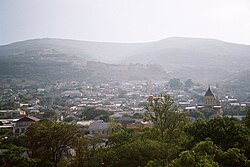Derbend
| Derbent (English) Дербент (Russian) Dərbənd (Azeri) Кьвевар (Lezgian) Дербенд (Avar) |
|
|---|---|
| - City - | |
 |
|
 Location of the Republic of Dagestan in Russia |
|
|
|
|
|
|
|
|
|
|
| Administrative status (as of April 2006) | |
| Country | Russia |
| Federal subject | Republic of Dagestan |
| Administratively subordinated to | City of Derbent |
| Capital of | Republic of Dagestan |
| Administrative center of | City of Derbent,Derbentsky District |
| Municipal status (as of October 2012) | |
| Urban okrug | Derbent Urban Okrug |
| Administrative center of | Derbent Urban Okrug, Derbentsky Municipal District |
| Statistics | |
| Area | 69.63 km2 (26.88 sq mi) |
| Population (2010 Census) | 119,200 inhabitants |
| - Rank in 2010 | 137th |
| Density | 1,712/km2 (4,430/sq mi) |
| Time zone | MSK (UTC+03:00) |
| Founded | 438 |
| City status since | 1840 |
| Postal code(s) | 368600 |
| Dialing code(s) | +7 87240 |
| on | |
 |
|
| UNESCO World Heritage Site | |
|---|---|
| Location |
Russia |
| Area | 69.63 km2 (749,500,000 sq ft) |
| Criteria | iii, iv |
| Reference | 1070 |
| Coordinates | 42°04′09″N 48°17′45″E / 42.0692°N 48.2958°E |
| Inscription | 2003 (27th Session) |
| Website | www |
|
[]
|
|
Derbent (Russian: Дербе́нт; Persian: دربند; Azerbaijani: Dərbənd; Lezgian: Кьвевар; Avar: Дербенд), formerly romanized as Derbend, is a city in the Republic of Dagestan, Russia, located on the Caspian Sea, north of the Azerbaijani border. It is the southernmost city in Russia, and it is the second-most important city of Dagestan. Population: 119,200 (2010 Census);101,031 (2002 Census);78,371 (1989 Census).
Derbent occupies the narrow gateway between the Caspian Sea and the Caucasus Mountains connecting the Eurasian steppes to the north and the Iranian Plateau to the south.
Derbent claims to be the oldest city in Russia with historical documentation dating to the 8th century BCE. Due to its strategic location, over the course of history, the city changed ownership many times, particularly among the Persian, Arab, Mongol, Timurid, Shirvan and Iranian kingdoms. In the 19th century, the city passed from Iranian into Russian hands by the 1813 Treaty of Gulistan.
Derbent is derived from modern Persian: دربند, translit. Darband, lit. 'Barred gate' (dar “gate” + band “bar,” lit., “barred gate”), referring to the adjacent pass. It is often identified with the legendary Gates of Alexander. The Persian name for the city came into use at the end of the 5th or the beginning of the 6th century AD, when the city was re-established by Kavadh I of the Sassanid dynasty of Persia, but Derbent was probably already in the Sasanian sphere of influence as a result of the victory over the Parthians and the conquest of Caucasian Albania by Shapur I, the second shah of the Sassanid Persians. Since antiquity, the value of the area as the gate to the Caucasus has been understood and exploited, and Derbent has archaeological structures over 5,000 years old. As a result of this geographic peculiarity, the city developed between two walls, stretching from the mountains to the sea. These fortifications were continuously employed for a millennium and a half, longer than any other extant fortress in the world.
...
Wikipedia



